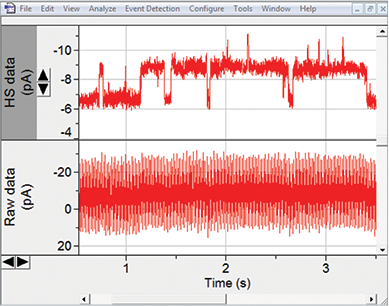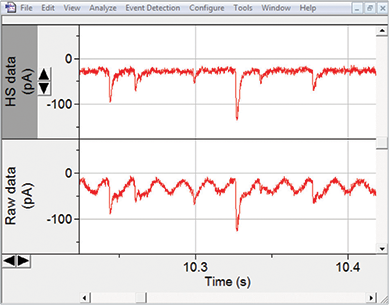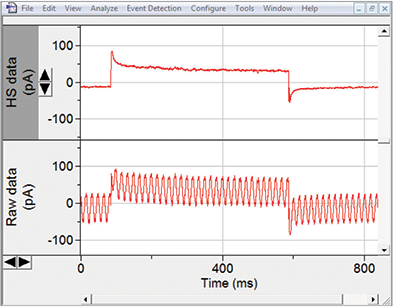
Application Note
HumSilencer: A smart and simple Axon Digidata 1550 Series feature for eliminating line-frequency noise
- Eliminates 50/60 Hz linefrequency noise in less than one second
- Built-in HumSilencer enabled by a single click
- Data acquisition with fewer interruptions to eliminate linefrequency noise
- Supports analysis of very small signals
Introduction
A major challenge in many electrophysiology laboratories is the elimination of 50 Hz or 60 Hz line-frequency noise and the associated high-frequency harmonics. Also called electrical hum, these interfering signals stem from the alternating current (AC) of the electrical mains and are delivered to the lab via power sockets and outlets.
Contamination with line-frequency noise can completely overwhelm biological signals of interest, making sensitive current or voltage measurements impossible. Therefore, elimination of line-frequency noise is critical. However, typical methods for handling this type of noise can be time-consuming and only partially effective. Experiments need to be temporarily stopped while the researcher embarks on a lengthy troubleshooting process to identify and either eliminate or shield the noise sources. While notch filter or off-line filtering methods can be employed, often times these filter-based methods do not fully remove electrical noise, and in some situations, can actually distort biological signals and impair data accuracy.
To rapidly and effectively eliminate linefrequency noise, Molecular Devices has developed the next generation of digitizers—the Axon™ Digidata® 1550 Series Low-Noise Data Acquisition System plus HumSilencer™ Adaptive Noise Cancellation (patent pending). The Digidata 1550 Series plus HumSilencer provides a smart and simple way to eliminate line-frequency noise at 50 Hz or 60 Hz and the associated high-frequency harmonics.
What is the HumSilencer feature?
The HumSilencer feature is an advanced, filter-free, adaptive technology that learns and removes local line-frequency noise patterns and associated high-frequency harmonics from incoming signals in less than one second. With a single click, HumSilencer enables sensitive and accurate electrophysiology data acquisition free from line-frequency noise.
Built into the Digidata 1550 A and B digitizers, the HumSilencer feature is accessed through Axon™ pCLAMP™ or Axon™ Axoscope software. Clicking a simple ON/OFF box enables/disables subtraction of line-frequency noise in real time during data acquisition.
If the pattern of the line frequency noise changes, such as by the introduction of a new noise source or through an increase in existing noise, HumSilencer rapidly learns and adapts. The new noise is eliminated in less than one second and can handle amplitudes up to 20V peak-to-peak at digitizer’s analog input.
The HumSilencer feature is not a filter and has no effect on acquired signals. The HumSilencer system also causes no signal distortion such as frequency change, amplitude, amplitude attenuation, phase shift, or DC voltage change.
Line-frequency noise elimination by HumSilencer
We validated the HumSilencer noise cancellation performance in a variety of applications. During these tests, wholecell, excised patch, and extracellular field potential recordings were made using Axon™ Axopatch™ 200B, Axon™ MultiClamp™ 700A, or Axon™ MultiClamp™ 700B amplifiers. The acquired signal was split into two analog input channels of the Digidata 1550A and digitized with analog input channel #0, using the HumSilencer feature. This enables comparison of raw data to data where the HumSilencer feature was used. Acquired and digitized signals were then analyzed using pCLAMP software version 10.5. If no line-frequency noise was observed during the recordings, an external noise generator was placed near the headstage to introduce exogenous linefrequency noise.
As demonstrated in the accompanying figures, the HumSilencer feature eliminates line-frequency noise and the associated high-frequency harmonics in a variety of electrophysiology applications.
Single-channel recordings
Figure 1 demonstrates the power of the Digidata 1550 Series plus HumSilencer in one of the most demanding applications— single-channel recording. Typical currents from single-channel recording are on the order of single to tens of picoamperes (pA). In the presence of \~40 pA of line-frequency noise, the small signal from the single channel is virtually invisible (Figure 1, bottom panel). However, with HumSilencer enabled, the biological signal is revealed (Figure 1, top panel).

Figure 1: HumSilencer (HS) enables accurate signal measurement in single-channel recordings (HumSilencer-subtracted data in top panel, raw data in bottom panel). Single-channel recording of the principal subunit of the olfactory cyclic nucleotide-gated channel (CNCA2). The excised membrane patch was isolated from HEK293 cells transfected with CNCA2, and the membrane clamped at +50 mV in the presence of 1 µM cGMP. Data courtesy of Tsung-Yu Chen, Ph.D., University of California, Davis.
Extracellular population spike recordings
The Digidata 1550 Series’s HumSilencer feature works with all types of electrophysiology studies, including extracellular field potential recordings from brain slices (Figure 2). When an exogenous noise source is placed near the headstage during recording of extracellular population spikes (PSs), the shifting baseline prevents accurate measurement of the extracellular PS (Figure 2, bottom panel). When HumSilencer is enabled, the noise is removed, the baseline flattens, and the extracellular PSs can now be accurately measured (Figure 2, top panel).

Figure 2: HumSilencer (HS) enables accurate measurement of extracellular field potential recordings (HumSilencer-subtracted data in top panel, raw data in bottom panel). Representative extracellular population spikes (PSs) recorded from the CA1 pyramidal cell body layer of a mouse hippocampus brain slice. PSs are evoked by a pair of electrical stimuli with a 50 ms inter-stimulation interval on the Schaffer collateral pathway. 60 Hz line-frequency noise was introduced to the experiment as described above. Data courtesy of John Huguenard, Ph.D., Stanford University
Whole-cell recordings
We also validated the Digidata 1550 Series plus HumSilencer in whole-cell recordings of spontaneous excitatory postsynaptic currents (sEPSCs). In the bottom panel of Figure 3, naturally occurring line-frequency noise partially obscures the biological signal from whole-cell recordings of sEPSCs from a C. elegans body-wall muscle cell. Only when the HumSilencer feature subtracts out the line-frequency noise does the biological signal become visible and can be accurately measured (Figure 3, top panel).

Figure 3: HumSilencer (HS) enables accurate signal measurement in whole-cell recordings. Representative whole-cell recordings of spontaneous excitatory postsynaptic currents (EPSCs) from a C. elegans body-wall muscle cell at -60 mV holding voltage; (bottom panel) raw data contaminated with endogenous 60 Hz line-frequency noise; (top panel) data with HumSilencer subtraction. Data courtesy of Zhao-Wen Wang, Ph.D., University of Connecticut Health Center.
Recordings from excised patches
The last validation shown here is of macroscopic endogenous current recordings of an inside-out excised patch from an HEK cell in response to a voltage step (Figure 4). The bottom panel of Figure 4 shows that evoked macroscopic currents were contaminated with introduced 60 Hz line-frequency noise. In the top panel of Figure 4, the robust, introduced linefrequency noise was effectively eliminated by the HumSilencer system.

Figure 4: HumSilencer (HS) enables accurate measurement of macroscopic currents from excised patches. Macroscopic current traces of inside-out patches excised from an HEK cell at -80 mV holding and repolarizing potentials, (top panel) HumSilencer-subtracted data, (bottom panel) raw data. Endogenous or leak currents were elicited in response to a step potential of 100 mV. Data courtesy of Huanghe Yang, Ph.D., University of California, San Francisco.
Conclusions
Here we have demonstrated the power of the Digidata 1550 Series’s HumSilencer feature and validated its effectiveness in four different applications. This is only a small set of applications that benefit from rapid line-frequency noise elimination using HumSilencer. We expect that virtually all electrophysiology studies—whether whole-cell patch-clamp or extracellular recordings—can make use of this feature. By eliminating 50 and 60 Hz noise and the associated high-frequency harmonics, HumSilencer not only prevents the risk of temporary experimental workflow stoppage, it also saves time by eliminating the need to track down noise source(s). With HumSilencer, even very small signals can now be accurately detected, enabling sensitive and accurate data acquisition.
Smart, simple, and powerful, the Digidata 1550 Series plus HumSilencer ushers in a new level of ease and confidence in electrophysiology data acquisition.